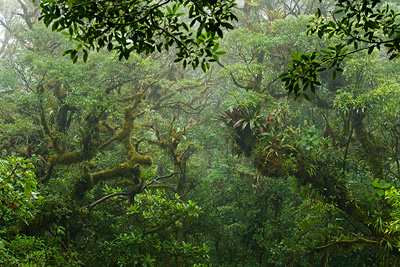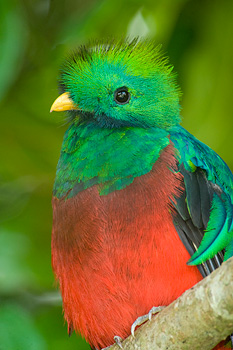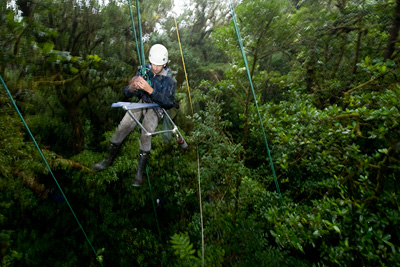Introduction to the Canopy

A view of the cloud forest canopy in Monteverde, Costa Rica. There is an incredible diversity of epiphytic plants growing on the branches of the trees, which in turn provide habitat for a diversity of animals.
We know very little about forest canopies. Many of the world's forest canopies remain unexplored and certainly hold undiscovered species. However, what we do know about the canopy is that it plays an important part in forest functioning. Forest canopies provide structure that affects weather patterns, contributes to nutrient cycling, and provides habitat for plants and animals, among other things. A lot remains to be discovered...there's room for new scientists to climb up and explore.
What Is A Forest Canopy?
Since trees reach different heights in different forests and there can be many layers of trees, defining the canopy is a difficult task. However, the canopy is considered the uppermost layer of plants, including all of the additional plant and animals living in that layer. The maximum height of the canopy can vary dramatically. In the tropical montane cloud forests of Monteverde, Costa Rica, the maximum height of the canopy varies from 15 to 40 meters (50-130 feet).
What Is The Weather Like Up There?
Sunlight reaches the canopy before any other part of the forest. As a result, it may be warmer and drier in the canopy than the forest below. Alternatively, plants in the canopy are the first to get wet when it rains. In both cases, the canopy affects the microclimate of the entire forest, reducing the sun and the wind that make it to the forest floor, and often increasing the humidity. The canopy creates the difference you feel when you walk from a hot, dry field into a cool, moist forest.

The Resplendent Quetzal, one of Monteverde's most spectacular canopy dwelling birds.
What Lives In The Canopy?
In many cases, we simply don't know what lives in the forest canopy. The canopy is home to an incredible diversity of plants and animals. In some cases, there are species that will never touch the forest floor, including many plants, birds, insects and even mammals. The tropical montane cloud forest canopy is a world unto itself.
Plants
In addition to the trees that form the primary structure of the canopy, there are many specialized plant groups that live on those trees, including climbers, epiphytes, hemi-epiphytes, and hemi-parasites. In tropical montane cloud forests, climbers may be vines, lianas, or palms, while epiphytes may be bromeliads, orchids, mosses, lichens, or ferns. The hemi-epiphytes include the famous strangler figs, while mistletoe is the most famous of the hemi-parasites. These plants may live entirely on soil layers that form on branches, or spend a part, or all, of their time rooted in soil. We don't have accurate estimates of the number of plant species that exist in most forest canopies, but in the tropical montane cloud forests of Costa Rica, the number is certainly in the hundreds.
Animals
The forest canopy has an incredible community of insects, amphibians, reptiles, birds, and mammals. In connection with the plants, they form an additional part of the forest food web. Animals in the canopy often play an important role in forest functioning. For instance, many tropical plants are dependent on birds and mammals to eat their fruits and disperse their seeds. While some animal life histories in the canopy have been studied, many have not, simply because the species have not yet been discovered. In one famous research study, 43 species of ants were discovered in a single tree. Estimates of the number of insect species in the world are in the millions and tropical forest canopies are likely home to many new species..

Scientists often use ropes to access the canopy, where they can then make measurements. Here, a cloud water collector is assembled.
How Do We Study The Canopy?
Leaving the ground and climbing into the canopy is a challenge and scientists have only established safe and reliable methods to do so in the last 50 years. Over the years, the most common methods have included using climbing ropes, large floating canopy rafts, building walkways, and canopy cranes. The priority is to minimize any harm to the plants and animals that make up the canopy.
References:
Lowman, M. D. and H.B. Rinker. 2004. Forest Canopies. Elsevier, Amsterdam.
Lowman, M.D., T.D. Schowalter and J.F. Franklin. 2012. Methods in Forest Canopy Research. University of California Press, Berkeley, CA.
Lowman, M., S. Devy, and T. Ganesh. 2013. Treetops at risk: challenges of global canopy ecology and conservation. Springer, New York, NY.
Wilson, E.O. 1987. The arboreal ant fauna of Peruvian Amazon Forests: A First Assessment. Biotropica 19:245-251.
